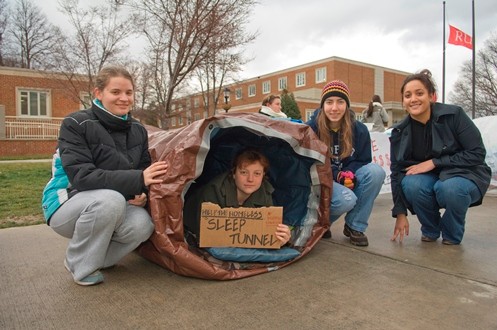Design Students' Creativity Benefits the Homeless
What does it feel like to be homeless? How do you sleep when there's nothing between you and the ground? What can be done to help?
Those tough questions are being addressed by students in Associate Professor Joan Dickinson's Sophomore Studio II class as part of a project to design and build portable shelters for the homeless.
When developing the project, Dickinson said, she had several goals in mind for her students, who are divided into six groups of three students apiece. Each team is researching, designing and building a distinctive portable structure.
"First, I wanted them to design for someone who is completely different from themselves," she said. "Second, I wanted students to gain a strong understanding of civic engagement and social justice. In other words, students should understand some of the severe problems that we face as a nation."

Team members (left to right) Megan Dreyer, Chasity Hanchey, Kelsea Staffor and Kristina Klingenberger pose with their portable shelter design.
On Wednesday the students took the prototypes of their portable structures to the promenade of the Hurlburt Student Center for a fundraising project to benefit two local charities: To Our House, a Montgomery County group that provides shelter and meals to homeless men, and New River Valley Family Shelter of Christiansburg, which houses homeless women and children.
Students gathered information on who the homeless are, how a person becomes homeless and the problems facing the homeless population. Their shelters were designed to take into account where a temporary structure could be located, who might use it and what materials were practical. In choosing materials they considered ventilation, thermal and moisture qualities, and studied temporary structures that have been used historically or in other cultures.
Through the design and creation process for each structure, students had to keep in mind who it was intended for and in what part of the country it would be most suitable. In addition, materials used in the construction could not be purchased. The entire structure had to be made out of common everyday materials or those that could be easily found.
Student Kelsey Hyser of Harrisonburg and her team built their shelter envisioning a teen runaway living on the streets in a warm climate like Los Angeles.
"I know if I was in that situation, I'd want a caring hand to reach out and help me," Hyser said as she and her team worked. Their curved-roof structure consisted of a wooden palette base with newspaper insulation, plastic wrap covering to reduce moisture and discarded carpeting for comfort.
Student Megan Dreyer, who grew up just outside of Baltimore, has seen the plight of the homeless firsthand but said what she learned during the shelter project was still an eye-opener.
Her group chose Alleghany County, N.C., because it is local. She was shocked, she said, "to learn the amount of homeless who are there, the amount of families who are homeless," and the number whose situations have to do with mental illness.
Dickinson is faculty advisor for RU's student chapter of the American Society of Interior Designers, which has an ongoing commitment to community service. She said she sees the shelter project as an extension of the chapter's mission.
"Over the last two years, we have been repairing and renovating homes for individuals who live below the poverty line," Dickinson said, noting that poverty and a lack of affordable housing are predictors of future homelessness.
"Through this work, we have seen families and individuals in Montgomery County who have experienced tremendous hardship," she said. "Working with these families gave me the idea of having our students design portable, temporary structures."
Dickinson said she has been far more interested in her students' journey and the valuable experience they gained than in the actual designs of their finished products.
"I want students to gain knowledge in who is homeless, how you become homeless and the problems and difficulties faced by the homeless," she said. "I hope they will also develop more empathy for those who are homeless. I'm really proud of them. I think they've done a great job in understanding the problem."
To make a donation to the charities benefiting from the students' project, contact Dickinson at jidickins@radford.edu.